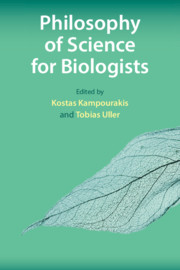Book contents
- Philosophy of Science for Biologists
- Philosophy of Science for Biologists
- Copyright page
- Contents
- Contributors
- Preface
- 1 Why Should Biologists Care about the Philosophy of Science?
- 2 What Constitutes an Explanation in Biology?
- 3 What Is Biological Knowledge?
- 4 What Is the Nature of Theories and Models in Biology?
- 5 How Are Biology Concepts Used and Transformed?
- 6 Why Does It Matter That Many Biology Concepts Are Metaphors?
- 7 How Do Concepts Contribute to Scientific Advancement?
- 8 How Can Conceptual Analysis Contribute to Scientific Practice?
- 9 What Methods Do Life Scientists Use?
- 10 Is It Possible to Scientifically Reconstruct the History of Life on Earth?
- 11 What Is the Basis of Biological Classification?
- 12 What Is the Nature of Scientific Controversies in the Biological Sciences?
- 13 What Is the Relation between Facts and Values in Biological Science?
- 14 A Philosopher in the Age of Creationism
- 15 How Can We Teach Philosophy of Science to Biologists?
- Further Reading
- Index
- References
10 - Is It Possible to Scientifically Reconstruct the History of Life on Earth?
The Biological Sciences and Deep Time
Published online by Cambridge University Press: 04 September 2020
- Philosophy of Science for Biologists
- Philosophy of Science for Biologists
- Copyright page
- Contents
- Contributors
- Preface
- 1 Why Should Biologists Care about the Philosophy of Science?
- 2 What Constitutes an Explanation in Biology?
- 3 What Is Biological Knowledge?
- 4 What Is the Nature of Theories and Models in Biology?
- 5 How Are Biology Concepts Used and Transformed?
- 6 Why Does It Matter That Many Biology Concepts Are Metaphors?
- 7 How Do Concepts Contribute to Scientific Advancement?
- 8 How Can Conceptual Analysis Contribute to Scientific Practice?
- 9 What Methods Do Life Scientists Use?
- 10 Is It Possible to Scientifically Reconstruct the History of Life on Earth?
- 11 What Is the Basis of Biological Classification?
- 12 What Is the Nature of Scientific Controversies in the Biological Sciences?
- 13 What Is the Relation between Facts and Values in Biological Science?
- 14 A Philosopher in the Age of Creationism
- 15 How Can We Teach Philosophy of Science to Biologists?
- Further Reading
- Index
- References
Summary
The data-based study of long past events and processes is common throughout the sciences. Some examples are the astrophysical hypotheses that the universe began with a cosmic explosion (“big bang”), which is supported by measurements of the cosmic microwave background radiation pervading the modern universe; the hypothesis that the end-Cretaceous mass extinction was caused by a meteorite impact, which is supported by an iridium anomaly and large quantities of shocked quartz in K-Pg (Cretaceous-Paleogene) boundary sediments; and the hypothesis that all life on Earth shares a common ancestor, which is supported by analyses of shared segments of ribosomal RNA found in contemporary organisms. My interest in the methodology of the historical sciences and how it differs from that of stereotypical or “classical” (as I later dubbed it) experimental science was first piqued in the 1990s by the writings of so-called “scientific [more accurately, biblical] creationists.” Scientific creationists and their successors, members of the “Intelligent Design Network,”1 extol classical experimental research (the testing of hypotheses under controlled laboratory conditions) as the paradigm of good science, contending that historical scientific research is inferior because it uses “a form of abductive reasoning that produces competing historical hypotheses, that lead to an inference to the best current explanation rather than to an explanation that is logically compelled by experimental confirmation.”2 Proponents of intelligent design are not alone, however, in denigrating the work of historical scientists. Articulating a view held by a surprising number of experimentalists, Henry Gee, at the time a senior editor of Nature, declared that no science can be historical because conjectures about the past cannot be tested by means of controlled laboratory experiments (Gee 1999).
- Type
- Chapter
- Information
- Philosophy of Science for Biologists , pp. 193 - 215Publisher: Cambridge University PressPrint publication year: 2020
References
- 1
- Cited by

